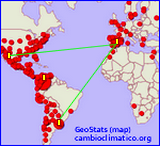(via Google Translate) Recognition and monitoring of the problem
* A significant achievement of the Convention, characterized by a general and flexible, recognizing that there is a problem.
This represented a big step a decade ago, when the treaty entered into force, because there was less evidence (and there are still those who doubt that global warming is real and that climate change is a problem.) It's hard to get the world's nations to agree on anything, let alone a common approach to a difficulty that is complex, the consequences are not entirely clear and that the most serious effects occur within several decades or even centuries.
* The Convention sets the objective of stabilizing emissions of greenhouse gases "to a level that would prevent dangerous anthropogenic interference with the climate system." It also states that "such a level should be achieved within a timeframe sufficient to allow ecosystems to adapt naturally to climate change, ensure that food production is not threatened and to enable economic development to proceed in a sustainable manner."
* The Convention calls for the establishment of accurate and regularly updated inventories of emissions of greenhouse gases in industrialized countries. The first step in solving the problem is to know its dimensions. With few exceptions, the "base year" for calculating emissions of greenhouse gases was 1990. It also encourages developing countries to develop inventories.
* Countries that have ratified the treaty, the "Parties to the Convention", according to diplomatic jargon-decide to take into account climate change issues in agriculture, industry, energy, natural resources and activities affecting marine littoral. Also agree to establish national programs for tackling climate change.
* The Convention recognizes that a document "frame", ie a text to be amended or developed over time to the efforts against global warming and climate change can be better targeted and more effective. The first addendum to the treaty, the Kyoto Protocol was adopted in 1997.
The member countries of the Convention on Climate Change meet annually
Responsibility and Vulnerability
* The Convention places the heaviest burden falling on the fight against climate change on industrialized countries, since they are the main source of most emissions of greenhouse gases in the past and today. These countries are requested to make every effort to reduce emissions from smokestacks and exhaust pipes and to provide much needed resources for efforts to be carried out elsewhere. In most cases, these developed nations, known as the "countries listed in Annex I, as listed on the first annex of the treaty, members of the Organization of Economic Cooperation and Development (OECD).
* These advanced nations as well as 12 "economies in transition (countries of Central and Eastern Europe, including some that belonged to the former Soviet Union), should by 2000 reduce emissions to 1990 levels. And together, they succeeded.
* Under the Convention commit industrialized nations to support developing countries in activities related to climate change by providing financial support, without prejudice to the assistance already provided to these countries. It has established a system of grants and loans through the Convention, which is administered by the Global Environment Facility (see "Bodies of the Convention and partner agencies).Industrialized countries have also agreed to share technology with less advanced nations.
* Since economic development is essential for the poorest countries in the world, and as such progress is difficult to achieve even without the additional complications of climate change, the Convention acknowledges that the emissions of greenhouse gases produced by developing nations grow in the coming years. However, try to help these countries to limit emissions without harming their economic progress.
* The Convention recognizes the vulnerability of developing countries to climate change and calls for special efforts to mitigate the consequences.


 IP registrada
IP registrada



















Comenta en Facebook